Nickel stimulates L1 retrotransposition by a post-transcriptional mechanism
- PMID: 16249005
- PMCID: PMC2971678
- DOI: 10.1016/j.jmb.2005.09.050
Nickel stimulates L1 retrotransposition by a post-transcriptional mechanism
Abstract
Sequence studies of the human genome demonstrate that almost half of the DNA is derived from mobile elements. Most of the current retrotransposition activity arises from L1 and the L1-dependent, non-autonomous elements, such as Alu, contributing to a significant amount of genetic mutation and genomic instability. We present data demonstrating that nickel chloride, but not cobalt chloride, is able to stimulate L1 retrotransposition about 2.5-fold. Our data suggest that the stimulation occurs at a post-transcriptional level, possibly during the integration process. The effect of nickel on the cell is highly complex, limiting the determination of the exact mechanism of this stimulation. The observed stimulation of L1 retrotransposition is not due to a general increase in L1 transcription or an increase in the number of genomic nicks caused by nickel, but more likely caused by a decrease in DNA repair activities that influence the downstream events of retrotransposition. Our observations demonstrate the influence of environmental toxicants on human retroelement activity. We present an additional mechanism for heavy-metal carcinogenesis, where DNA damage through mobile element activation must be considered when dealing with genomic damage/instability in response to environmental agents.
Figures
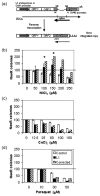
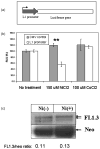
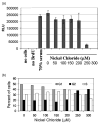

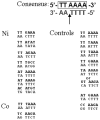
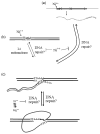
Similar articles
-
Heavy metals stimulate human LINE-1 retrotransposition.Int J Environ Res Public Health. 2005 Apr;2(1):14-23. doi: 10.3390/ijerph2005010014. Int J Environ Res Public Health. 2005. PMID: 16705797 Free PMC article.
-
Mercury specifically induces LINE-1 activity in a human neuroblastoma cell line.Mutat Res Genet Toxicol Environ Mutagen. 2014 Jan 1;759:9-20. doi: 10.1016/j.mrgentox.2013.07.015. Epub 2013 Nov 13. Mutat Res Genet Toxicol Environ Mutagen. 2014. PMID: 24240092
-
The L1 retrotranspositional stimulation by particulate and soluble cadmium exposure is independent of the generation of DNA breaks.Int J Environ Res Public Health. 2006 Jun;3(2):121-8. doi: 10.3390/ijerph2006030015. Int J Environ Res Public Health. 2006. PMID: 16823085 Free PMC article.
-
Long INterspersed element-1 mobility as a sensor of environmental stresses.Environ Mol Mutagen. 2020 Apr;61(4):465-493. doi: 10.1002/em.22366. Epub 2020 Mar 17. Environ Mol Mutagen. 2020. PMID: 32144842 Review.
-
Biology of mammalian L1 retrotransposons.Annu Rev Genet. 2001;35:501-38. doi: 10.1146/annurev.genet.35.102401.091032. Annu Rev Genet. 2001. PMID: 11700292 Review.
Cited by
-
Modes of retrotransposition of long interspersed element-1 by environmental factors.Front Microbiol. 2012 May 31;3:191. doi: 10.3389/fmicb.2012.00191. eCollection 2012. Front Microbiol. 2012. PMID: 22666219 Free PMC article.
-
Environmental exposures and gene regulation in disease etiology.Environ Health Perspect. 2007 Sep;115(9):1264-70. doi: 10.1289/ehp.9951. Environ Health Perspect. 2007. PMID: 17805414 Free PMC article. Review.
-
The reverse transcription inhibitor abacavir shows anticancer activity in prostate cancer cell lines.PLoS One. 2010 Dec 3;5(12):e14221. doi: 10.1371/journal.pone.0014221. PLoS One. 2010. PMID: 21151977 Free PMC article.
-
Evolutionary conservation of the functional modularity of primate and murine LINE-1 elements.PLoS One. 2011 May 10;6(5):e19672. doi: 10.1371/journal.pone.0019672. PLoS One. 2011. PMID: 21572950 Free PMC article.
-
Interstrand crosslinking oligonucleotides elucidate the effect of metal ions on the methylation status of repetitive DNA elements.Front Chem. 2023 Jan 13;11:1122474. doi: 10.3389/fchem.2023.1122474. eCollection 2023. Front Chem. 2023. PMID: 36711237 Free PMC article.
References
-
- Lander ES, Linton LM, Birren B, Nusbaum C, Zody MC, Baldwin J, et al. Initial sequencing and analysis of the human genome. International Human Genome Sequencing Consortium. Nature. 2001;409:860–921. - PubMed
-
- Chen JM, Stenson PD, Cooper DN, Ferec C. A systematic analysis of LINE-1 endonuclease-dependent retrotranspositional events causing human genetic disease. Hum Genet. 2005;117:411–427. - PubMed
Publication types
MeSH terms
Substances
Grants and funding
LinkOut - more resources
Full Text Sources

